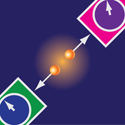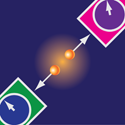Reality, locality, and “free will”
In 1964, John Bell devised a testable prediction (now known as Bell’s inequality) based on two reasonable assumptions: that the measurement of one particle cannot instantaneously influence another, distant particle (locality) and that particles have properties before you measure them (reality). Numerous experiments have since shown that Bell’s inequality is violated, forcing one to conclude that, contrary to the view held by Einstein, Podolsky, and Rosen, quantum mechanics cannot be both local and real.
But what of other assumptions built into Bell’s inequality? In a paper appearing in Physical Review Letters, Michael Hall at the Australian National University in Canberra considers an assumption, called measurement independence, in the following experimental paradigm: A source emits two particles in an entangled state and sends them to two distant laboratories, where two experimenters randomly choose apparatus settings that measure a system property. The measurement outcomes can be correlated in a way that violates Bell’s inequality, but measurement independence assumes that the experimenters freely choose apparatus settings, independent of any properties of the systems that they measure. By relaxing this assumption, Michael Hall constructs a local and real model that describes the correlations of the experiment. He shows that locality and reality can be retained with a reduction of the experimenters’ “free will”—that is, the assumption of measurement independence need not be given up completely. – Sonja Grondalski





